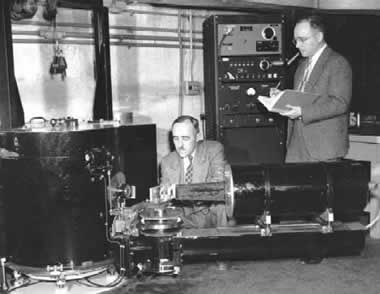| << Chapter < Page | Chapter >> Page > |
The first neutron diffraction experiment was in 1945 by Ernest O. Wollan ( [link] ) using the Graphite Reactor at Oak Ridge. Along with Clifford Shull ( [link] ) they outlined the principles of the technique. However, the concept that neutrons would diffract like X-rays was first proposed by Dana Mitchell and Philip Powers. They proposed that neutrons have a wave like structure, which is explained by the de Broglie equation, [link] , where λ is the wavelength of the source usually measured in Å, h is Planck’s constant, v is the velocity of the neutron, and finally m represents the mass of the neutron.

The great majority of materials that are studied by diffraction methods are composed of crystals. X-rays where the first type of source tested with crystals in order to determine their structural characteristics. Crystals are said to be perfect structures although some of them show defects on their structure. Crystals are composed of atoms, ions or molecules, which are arranged, in a uniform repeating pattern. The basic concept to understand about crystals is that they are composed of an array of points, which are called lattice points, and the motif, which represents the body part of the crystal. Crystals are composed of a series of unit cells. A unit cell is the repeating portion of the crystal. Usually there are another eight unit cells surrounding each unit cell. Unit cells can be categorized as primitive, which have only one lattice point. This means that the unit cell will only have lattice points on the corners of the cell. This point is going to be shared with eight other unit cells. Whereas in a non primitive cell there will also be point in the corners of the cell but in addition there will be lattice points in the faces or the interior of the cell, which similarly will be shared by other cells. The only primitive cell known is the simple crystal system and for nonprimitive cells there are known face-centered cubic, base centered cubic and body centered cubic.
Crystals can be categorized depending on the arrangement of lattice points; this will generate different types of shapes. There are known seven crystal systems, which are cubic, tetragonal, orthorhombic, rhombohedral, hexagonal, monoclinic and triclinic. All of these have different angles and the axes are equally the same or different in others. Each of these type of systems have different bravais lattice.

Notification Switch
Would you like to follow the 'Physical methods in chemistry and nano science' conversation and receive update notifications?